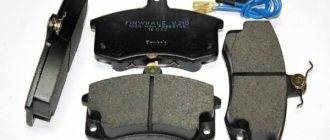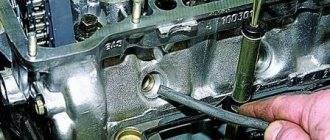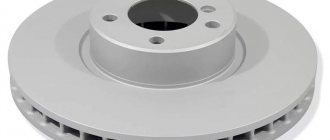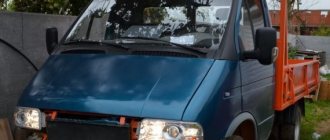Brake pads are one of the most important parts of a car's braking system. They are responsible for the stability and efficiency of the brakes, protecting the disc and drum from possible damage. The performance of the entire braking system directly depends on the quality of the brake pads.
Classification of brake pads
It is easy to distinguish three main types of pads. They differ not only in the quality of the material used, but, of course, also in cost. The spread is quite large. Let's figure out what brake pads are?
Brake pads of the first category
They are often called "conveyor". The first category includes only the best brake pads. Such parts are used by car manufacturers directly during the assembly of the car. This type is the most “strong” category of parts. They meet all automaker quality standards. In addition, the pads must undergo repeated testing for strength, wear, etc. This set of advantages is closely related to the market value of the parts.
It is important to note that the small portion of assembly line brake pads that end up on the auto parts market actually cost a lot of money. Plus, it is extremely difficult to find and purchase them, because most of the brake pads produced according to these standards are purchased directly by automakers and sent to the factory assembly line with subsequent installation directly on a new car.
“Original” brake pads put on the market for free sale are marked with the brand of the automaker, and not with the brand of the pad manufacturer. At the same time, the same spare part manufacturer actually does not in any way limit its own production of the same pads under its own brand. Simply put, this means that completely different packages can hide identical parts, but with a cost difference of 10-30%.
On average, only 10% of original brake pads produced are put on sale, so finding them on the regular car market is a very difficult task. If you strictly follow the policy of using only original spare parts, you can purchase such pads in a specialized store or on order. There is a wider choice here: many online stores have a similar offer. The only question is the delivery time.
Brake pads of the second category
Sometimes manufacturers of “non-original” (Aftermarket) brake pads achieve a significant price reduction (by a third compared to original parts) due to the use of lower quality materials in the production process. This is followed by a noticeable reduction in the service life of the part (you will need to replace the brake pads much more often). With proper selection of non-original consumables, you can achieve almost the same performance, as well as durability, as from original products of the first category. Below we will tell you how you can identify a quality product?
Export brake pads (3rd category)
It is easy to assume based on the name that pads of this subtype are not used for sale in the car market of the country of origin. Parts of this type are exported to so-called developing countries. Such countries should be understood as states with a low standard of living, economic development and infrastructure. As a result, within developing countries there is a system of standards and requirements for imported products with reduced quality criteria. Cheap and low-quality goods are sent directly to countries where the manufacturer, in principle, has the opportunity to sell it. Of course, the cost of such parts is minimal, but they will not last very long (unless, of course, you use the car for its intended purpose once a month).
Should you save on braking: comparing expensive and cheap brake pads
What's the point?
Brake pads have many characteristics, according to which they are tested by serious guys in white coats in laboratories at various stands and other high-tech devices. It turns out to be generally interesting, but it is not always clear what to choose in the end, what to pay attention to and what to pay for. Therefore, we will make everything much simpler and closer to practice. Let’s take a car: we’ll put original (and, of course, expensive) brake pads on one side, and cheap analogues on the other side. Along the way, we will carry out some minimal measurements that will provide exactly the information that the driver will feel on his own skin (more precisely, his leg). And at the end of the second part of our “pseudo-scientific” narrative, we will conclude: is it worth paying for original parts? Or can you buy an analogue for a third of the price and be a happy and slightly richer car owner?
Articles / Practice Disc brakes: typical breakdowns and repairs Why do the pads “squeak” and why does the brake pedal vibrate? What causes a brake caliper to jam and what can be done about it if you don’t even have a repair kit at hand? We are studying the design of modern... 54904 3 26 08/10/2016
We chose the Skoda Yeti as an experimental car, but it’s not quite simple. And it’s not even a matter of good equipment (1.8 liter, TSI, 152 hp, all-wheel drive and DSG), but a driver who agreed to risk his movable property for our selfish purposes. Ilya is the best fit for our experiment: he doesn’t know how to drive quietly - his motorsport past periodically goes to his head, the pads sometimes smoke, the discs melt, and Ilya gets perverted pleasure from all this. Therefore, by the end of the experiment (and it will not last so long), we are waiting for the pads to be pretty worn out and a detailed story mentioning smoke from the wheels.
What are we going to stage?
So, our first task is to select the pads to be tested. How are things going with the original pads? We ordered them from the original catalog according to the VIN code of the car. And what did we get? On the boxes, of course, it simply says Volkswagen (sometimes Volkswagen Group), and to finish it off – Made in Germany. On the rear ones (their article number is 5K0 698 451 A, according to the catalog) there is a more specific inscription - Bosch. The front pads according to the article number (5K0 698 151) remained under the Volkswagen name. For the entire set they paid exactly 10,000 rubles (and this is taking into account the discount).
The second set turned out to be more difficult. The fact is that it was impossible to buy “completely Chinese” pads as a set - some make only front pads, others only make rear pads. The situation is the same with domestic parts, so we settled on EGT products. What kind of company is this, some may ask? EGT (European General Technologies) is a Lithuanian company that sells spare parts from 70,000 different manufacturers under its brand, and of the highest quality. Let's try to be unbiased and believe what this company says about itself on its website. By and large, it is impossible to find out what is in the boxes with three letters alien to the Russian spirit. And the same three letters are written on the pads themselves. Judging by the price of three and a half thousand per set, it’s unlikely that there’s anything too good packed in there. But let's see - what if?
We judge by clothes
Any more or less savvy car enthusiast will begin to evaluate the pads by the type of their packaging. We are also not born with bast, so let's look at the boxes.
Overall the EGT box looks pretty decent. There is even a sticker with a hologram, and the inscriptions are applied evenly. And although the quality of printing is far from ideal, the message “German quality” is read well. Texts with short instructions on the box - without the monstrous number of errors typical of typical Chinese manufacturers. We will attribute some liberties in punctuation and in the arrangement and use of prepositions to the fact that those who worked on the packaging were not native speakers of the great and mighty language, but of some other language. However, now they write much worse on the Internet.
The packaging of the original pads is different, and the front ones are in a modest “monochrome” box, familiar to the eye of a lover of the German automobile industry, with the manufacturer’s address clearly indicated. There is also a call to throw away packaging correctly, and not haphazardly (ecology, we understand everything, right, Volkswagen?). But the box with rear pads looks much simpler, although all the necessary information is indicated quite clearly and unambiguously on it. Both original boxes contain a complete list of pad applicability on various cars of the concern. There is no such information on EGT boxes - they are more concerned with their own advertising.
What is inside?
You just need to pick up the pads and it’s immediately clear what’s worth ten thousand and what’s three. The surfaces of the pads themselves on the original are smooth and even, on the EGT they are chipped and chipped. The rivets on the original pads are smooth and painted, but on the replacements they look as if they were processed with a hammer by the blacksmith Vakula. The material of the linings is also completely different to the touch: on expensive pads it is smooth, but on cheap pads it looks like a whetstone (I hope the brake discs will survive the test).
And now the intrigue: in the box of the original pads there are instructions. A huge footcloth in which we find the Russian language and read the first line: NHCTRYKLNRUOMOHTSYWOGHWO... What, excuse me? In general, everything is clear - we won’t even try to read what is written there after the word “BHNMAHNE”. It is clear that there are problems with the Cyrillic alphabet in Europe. And not only with it: the instructions are absolutely unreadable. At EGT, they were afraid to embarrass themselves and did not include the instructions at all.
Now let’s take a caliper in our hands and measure the thickness of all the pads. Just in case, we will measure each pad in three places.
The front pads from both manufacturers were perfect at all measurement points: 20 mm. The thickness of the rear original pads turned out to be 18 mm, the analogues – 17.5 mm. But we note that both sets turned out to be even, and we could not find a difference in thickness in different areas of the same block.
The box with the original pads also contained spacers for the floating bracket; the EGT box did not have this luxury. But each block was sealed in polyethylene, which the originals did not have.
We have already talked in detail about how disc brakes work and how to change pads . Therefore, without further ado, we carry out our diabolical plan and put EGT on the right, and the original on the left. After which, satisfied with the accomplished deed, we move on to the brake tester.
Many or few?
Many people know how measurements are carried out on a brake tester. Nothing supernatural happens on it: the car on roller skates accelerates and then slows down. The operation is performed twice, for the front and rear axles separately. We used a good stand from the famous company MAHA. The full printout obtained from a service specialist is located just below. What interesting things can our inquisitive mind learn from a pile of numbers?
In general, the difference between the right and left sides is small. You can even undergo a technical inspection if necessary. But it is there, and let’s pay attention: both in front and behind the run-up between the magnitude of the braking force differs by 13%. Moreover, on the right it is smaller in both cases. Let me remind you: there are pads from the box with the inscription EGT.
But there is practically no difference in the strength of the parking brake; the difference in the maximum braking force is only 2%, which cannot be taken seriously.
Dodging the tomatoes flying at me, I will try to find an excuse for the measurement taken. Yes, it would be worth doing this after 200-300 kilometers. But everything written above is only the first part of the Marlezon ballet with pads, but there will also be a second, where we will measure the same pads after a certain number of kilometers traveled, and at the same time look at their wear. And for disc wear if the car owner is unlucky. By the way, what does Ilya think about braking on new, but different pads?
It feels like the car pulls a little to the right when braking.
But I am inclined to believe that the reason is uneven roads, since the pads on the right should in theory be worse. But the general impression is that mine were a little cooler. The pedal became softer. Ilyatest owner
A little clarification is required here: firstly, a record amount of snow fell in St. Petersburg, so it’s impossible to fully evaluate anything other than traffic jams. Secondly, these impressions are the result of driving for several days, before which the car was equipped with Brembo products.
Let's see what will happen next.
For assistance in preparing the material, we would like to express our gratitude to Discount Auto Service ROLF (St. Petersburg, Savushkina St., 103, lit. B).
Basic principles for choosing pads
We hasten to assure you that the selection of brake pads should begin with an analysis of the first and second categories. You should not turn to category No. 3 (export pads) at all (except in very extreme cases), since this will significantly complicate your life in the near future, creating the need for frequent replacement of parts.
You should also make sure that the brake pads you plan to purchase and the brake rotors installed on your vehicle are made by the same manufacturer. If this is not the case, it will be enough to check the composition of the mixture (it should be identical). This will help avoid unpleasant sounds when braking after replacing the pads.
The next important principle is to avoid fakes! It is better to use a licensed non-original part than a fake of an original of dubious quality. We will not dwell separately on all the methods of identifying fakes; we will draw your attention to only a few main factors that will help you understand that this is a fake part:
- lack of instructions, product passport, warranty card in the packaging;
- erased or unclear product markings;
- absence of a certification mark on the body of the part (for example, 90R);
- low operating temperature of the pads.
In addition, on the pads of modern manufacturers you can often find a unique product code (analogous to a VIN code for cars). If there is a need to check a specific product, you can enter this code on the manufacturer’s website to ensure the quality of the brake pads.
Which brand of brake pads is better to choose?
Not a single modern manufacturer has a significant leadership in this niche, although we can still highlight some brands that cope with the task of balancing price and quality a little better than their competitors.
In order to determine the target brake pad manufacturer, you should determine for yourself what driving style is relevant to you?
City cars, from which, as a rule, drivers do not “squeeze all the juices out,” are equipped with brake pads manufactured by TRW. They are designed for quiet city driving. The operating temperatures of such pads are not too high, but the product will not fail in normal operating conditions. Also included in this category are Remsa brand pads. In fact, these products are produced under the same license as TRW, but some performance characteristics are still different (Remsa, by the way, may be a little cheaper).
Budget city options also include brake pads from some Russian manufacturers, for example, STS. This brand makes pads of quite decent quality (naturally, in terms of the declared cost). The pads from this manufacturer are quite suitable for installation on a budget car with a careful driving style.
Car enthusiasts who prefer a sporty driving style use Brembo, ATE or Fedoro brake pads. According to official information from the manufacturer, the operating temperature of such products can reach extremely high levels (about 800 degrees). This indicates decent performance characteristics of the material used in production. Various independent tests, by the way, only confirm the advantages of these models for sports cars.
Premium pads include products from the PAGID brand. Such pads are installed as conveyor pads on premium cars manufactured by Porsche, VW and many others. They are mainly used by German companies (and we all remember the quality of German cars, don’t we?).
How to choose brake pads in a store
Before paying for brake pads, you should definitely conduct their initial analysis. Having chosen the required option based on materials, sizes and manufacturer, it would be a good idea to ask the sellers if there are documents for the brake pads. It is especially important to find out about the authenticity of the pads if we are talking about buying them in a “small-town” store, where there is doubt about the quality of the product.
Try to avoid the cheapest pad options when purchasing. If you see a ceramic version of pads on sale from an unknown manufacturer at the price of a semi-metallic part from a familiar brand, it is better to give preference to the second option. Remember that the braking system, and with it your life, depends on the proper functioning of the pads.
When purchasing, inspect the pads externally. Please ensure that they are free of chips, scratches, cracks, shavings and other industrial debris. It would be a good idea to look at the technical characteristics of the pads you are purchasing - friction coefficient, declared wear rate and resistance to overheating.
( 435 votes, average: 4.51 out of 5)
How to soften a car's suspension
How to properly use a turbocharged car engine










